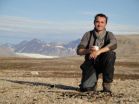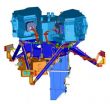(Press-News.org) A calcium-sensing protein, STIM1, known to activate store-operated calcium channels has been found to also inhibit voltage-operated calcium channels, according to researchers at Temple University.
The researchers published their findings, The Calcium Store Sensor, STIM1, Reciprocally Controls Orai and Cav1.2 Channels, in the Oct. 1 issue of Science magazine (www.sciencemag.org).
Calcium, not just important for bones and teeth, is a universal signaling agent that is pivotal in controlling a wide range of cell functions including fast muscle and nerve responses and slower response such as cell division, cell growth, apoptosis or programmed cell death and even fertilization of eggs.
Calcium is stored in cells and rapidly released out and pumped back to control things like contraction of muscle or the triggering of immune cells said Donald Gill, Professor and Chair of Biochemistry in Temple's School of Medicine and the study's lead researcher.
He said that the STIM1 protein, which he helped discover about 5 years ago, was found to play a major role in sensing the low levels of calcium in cell stores and activating the highly selective Orai calcium channel to allow calcium to flow back into the cell.
"We thought it seemed crazy that the STIM1 protein goes through this incredible dance but the only thing it does is activate the Orai channel," he said. "It seemed difficult to believe it only had this one specific function."
About two years ago, Gill and his colleagues noticed that in addition to activating the Orai channel to allow calcium to trickle back into the cell stores, STIM1 was also inhibiting the function of the crucial and widespread voltage-operated calcium channel, known as the L-type—channel.
"At the time, we thought only electrically excitable cells, like cardiac, neural and skeletal cells, had L-type (or long-lasting) calcium channels," he said. "So it was surprising that the STIM1 protein known to function mostly in non-excitable cells was having a pretty profound effect on the L-type calcium channels".
"This is particularly true in tissue like smooth muscle where it is sort of like a hybrid between an excitable and a non-excitable cell, because it has the voltage-operated calcium channel and the Orai calcium channel, as well as the very powerful STIM sensing system," he said.
Gill said that the researchers' finding gives a common mechanism for calcium signaling in both excitable and non-excitable cells, a link that was never before known.
"It's a very basic finding, but it's another whole area of control that people didn't know about before," he said. "They knew there were L-type calcium channels in many non-excitable cells, but they didn't seem to have any function. Now it seems very possible that the reason they didn't function is that the STIM1 protein was suppressing their function."
INFORMATION:
The study was funded by grants from the National Institutes of Health and Novartis Institutes for Biomedical Research.
END
An analysis of geological records that preserve details of the last known period of global warming has revealed 'startling' results which suggest current targets for limiting climate change are unsafe.
The study by climate change experts at the University of Exeter has important implications for international negotiators aiming to agree binding targets for future greenhouse gas emission targets.
Professor Chris Turney and Dr Richard Jones, both from the University's Department of Geography, have reported a comprehensive study of the Last Interglacial, a period of warming ...
The convergence in the coming year of three cyclical conditions affecting ocean temperatures and weather is likely to create unprecedented challenges for states that depend on water from the Colorado River, a new UCLA study suggests.
"If I were concocting a recipe for a perfect drought, this would be it," said Glen MacDonald, co-author of the study and director of UCLA's Institute of the Environment and Sustainability.
Along with a former graduate student, MacDonald has found that the combination of La Niña with two less commonly known ocean conditions — the Pacific ...
CORVALLIS, Ore. – Faster development of the promising field of cellulosic biofuels – the renewable energy produced from grasses and trees – is being significantly hampered by a "deep and thorny regulatory thicket" that makes almost impossible the use of advanced gene modification methods, researchers say.
In a new study published today in the journal BioScience, scientists argue that major regulatory reforms and possibly new laws are needed to allow cellulosic bioenergy to reach its true potential as a form of renewable energy, and in some cases help reduce greenhouse ...
BUFFALO, N.Y. -- Biomedical researchers at the University at Buffalo have engineered adult stem cells that scientists can grow continuously in culture, a discovery that could speed development of cost-effective treatments for diseases including heart disease, diabetes, immune disorders and neurodegenerative diseases.
UB scientists created the new cell lines – named "MSC Universal" – by genetically altering mesenchymal stem cells, which are found in bone marrow and can differentiate into cell types including bone, cartilage, muscle, fat, and beta-pancreatic islet cells. ...
ROCHESTER, Minn. -- In a review article published in the October issue of Mayo Clinic Proceedings,(http://www.mayoclinicproceedings.com) Mayo Clinic physicians differentiate the ethical and legal permissibility of withholding or withdrawing life-sustaining treatments and accepted comfort measures, specifically palliative sedation, from that of physician-assisted suicide or euthanasia.
Physician reviewers find that palliative sedation has an important place on the continuum of appropriate palliative care. "At the end of life, patient goals often shift to comfort, and removal ...
What does it take to save a species in the 21st century? The specter of climate change, with predicted losses to biodiversity as high as 35 percent, has some scientists and managers considering taking their conservation strategies on the road.
Managed relocation (MR) is literally the physical relocation of endangered or threatened species of plants and animals, by humans, to new, and foreign geographical climes. It addresses the concern that climate shifts may make many species' historical ranges environmentally inhospitable, and that the rapid speed of change and habitat ...
In a "marriage" that U.S. east coast residents would object to, the remnants of Tropical Storm Nicole coupled with an upper level low pressure area have dumped record rainfall from the Carolinas to New England on Sept. 30. The GOES-13 Satellite captured that massive "union" of a system as it begins to push off the northeastern U.S. coast today, Oct. 1.
At 1401 UTC (10:01 a.m. EDT) on Oct. 1, the Geostationary Operational Environmental Satellite called GOES-13 captured a visible image of the extensive cloud cover of this coupled system. The GOES image shows the system's ...
A major instrument due to fly aboard NASA's James Webb Space Telescope is getting its first taste of space in the test facilities at the Rutherford Appleton Laboratory (RAL) in the United Kingdom. The Mid-InfraRed Instrument (MIRI) has been designed to contribute to areas of investigation as diverse as the first light in the early Universe and the formation of planets around other stars.
"The start of space simulation testing of the MIRI is the last major engineering activity needed to enable its delivery to NASA. It represents the culmination of 8 years of work by the ...
The use of computer-aided detection (CAD) is increasing, in both screening and diagnostic mammography, according to a study in the October issue of the Journal of the American College of Radiology (www.jacr.org). CAD software systems highlight and alert the radiologist of abnormal areas of density, mass or calcification on a digitized mammographic image (of the breast) that may indicate the presence of cancer.
Screening mammography is an X-ray exam of the breast that is used as a screening tool to detect early breast cancer in women experiencing no symptoms. Diagnostic ...
Researchers working in a radiology department at a mid-sized hospital were able to increase productivity and improve efficiency by developing a simple method for measuring general technologist productivity, according to a study in the October issue of the Journal of the American College of Radiology (www.jacr.org).
"Improving productivity and maintaining team spirit are often competing priorities that may be difficult to achieve simultaneously," said C. Daniel Johnson, MD, co-author of the study. "In an era of cost reductions, radiology departments need to be able to ...



